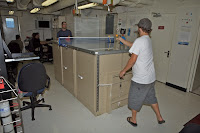Land Ho!!!!


After 9 days and two thousand nautical miles (2,300 miles) the call went out at 2:00 this afternoon. Wake Atoll, a tiny dot of land in the middle of the Pacific had peaked over the horizon. With a maximum elevation of 20, hers wasn't the most formidable coastline, but as our first sight of land, it was a welcome sight. The water is still the clearest blue and we now have visitors - birds, primarily boobies and petrels, keeping us company.
We had our final pre-dive emergency drill this afternoon which simulated a dive accident in which a diver was transported from a small boat back to the HI'IALAKAI and then into the re-compression chamber. All went smoothly and I can report that our patient made a full and complete recovery.
Tomorrow will be our first day of operations and we are all excited. Gear is ready, tanks are filled and checked, and the boats are ready. We will spend the next four days surveying around the island and in the lagoon. Our past experience here suggests it will be amazing. Clouds of fish of all different species, many of which we do not find in great numbers anywhere else in the Pacific. If the water off the side of the ship is any indication, visibility will be incredible and, oh, did I mention, the water temperature is 81 DEGREES!!! I have been waiting to dive without a wet-suit again for the last 2 years. SInce the last time we were in the Marianas.
Well, I haven't been sleeping too well for the past couple of nights, so I think I am going to wrap this up and hit the rack. We have an early morning tomorrow Up at 6. Pre-dive meeting at 7:30. Launch the boats by 8:00. It should be a great day.



















